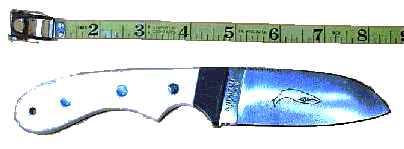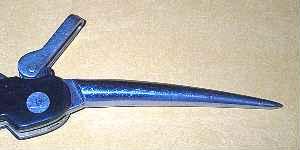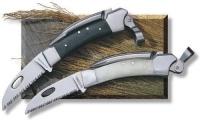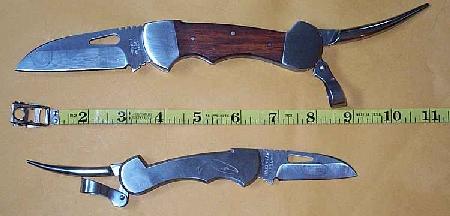

I confess, I enjoy working with knives almost as much as I enjoy knotting. To do decent knotting, you always need good tools, but it seems most tyers grab whatever knife is at hand to do their cutting. On this page I've put together some thoughts of mine on knives for knotting. Opinions are mine, take them for whatever they are worth.
| Buck 103 Skinner |
|---|
 |
| Henckels 8" Carving Knife |
 |
The first consideration for choosing a knife is the shape of the blade. Anyone who has looked at knives knows that there are a variety of shapes -- why? Well, they cut differently! Consider the curve of the cutting edge. More heavily curved blades are good for slashing with long strokes, where the blade should contact what it is cutting for a considerable amount of arm movement. A skinning knife, for example, will have a large "belly". A straight edge is better for control of what you are cutting, especially on short strokes. A bread knife will have a very straight edge, and a carving knife will be mostly straight, with a very small "belly".
| CRKT Mirage with Wharncliffe Blade |
|---|
 |
| Craftsman Stockman with sheepsfoot blade |
 |
Most knife work with knotting is, I believe, small fairly precise work, and a straight, or nearly straight, blade is preferable. (A very slight belly may be handy when laying small cord on a block to trim it, allowing a little rocking motion.) Several blade shapes have a mostly straight edge, such as the sheepsfoot, or wharncliffe style blades.
Should the blade have a pronounced point, like the wharncliffe, or should it be fairly blunt, like the sheepsfoot? Both will work well, but there is a minor difference. A sharp point has little advantage for knotting, in my opinion. Rarely do you need to poke into something. On the other hand, it can snag your work, stick you when doing some close cutting, or otherwise cause problems. Sailor's knives traditionally do not have much of a point, whether it was to reduce fights or reduce accidental cuts of sails, I can't say. (probably both!). Nonetheless, I much prefer something without a pronounced point for working with rope and cord. The sheepsfoot blade shape, or variations on it, is my choice, and it is the traditional one, also.
Sheepsfoot blades can be found on many specialized knives, which I'll discuss further, but are also found on almost every three blade stockman pocket knife, so they're not hard to find.
Here we're getting into personal preference, and intended type of rope work. Serrations are designed to cut through fibrous material (i.e. rope) quickly. A rescue knife, such as the Spyderco rescue, will eat through a half inch rope, or a seatbelt, on a single pull. In addition, its blunt sheepsfoot blade is designed to allow you to get under a seatbelt and pull, without risking injury to whoever is underneath it. I keep one of these in my car at all times, though I've thankfully never had to use it for its intended purpose. Also, though I've not experienced this personally, I've been told by a very knowledgeable source that wet polypropelene rope will not cut well with a straight edge no matter how sharp, so serrated edges may be preferable in this environment. Polypropelene is common in some aquatic usages.
| Spyderco Rescue Knife |
|---|
 |
Having said that, though, I do not like serrated knives for rope working in general. A quick cut with a serrated blade is frequently not a neat cut. A sharp plain blade will cut very well, and allow much finer control of the cutting. If you are cutting large amounts of thick cord or rope, a serrated blade might be appropriate, but I avoid them for my knotting purposes.
Chances are you will not be too concerned about this - a knife for knot work will not get too heavily used, so you probably won't want to (or be able to) invest in the highest quality steel. Be aware, though, that as a very general rule, the more "stainless" a steel is, the less it's ability to hold a sharp edge, and I like my knives to be sharp! Steels such as 440A or 425HC are resistant to rust and staining, but are generally cheaper, and require more work to keep their edge. ATS-34, BG-42, and 440C are higher end steels, which may be more likely to rust or stain, but are better at keeping an edge. If you take care of your knife, oil it and keep it sharp, that should not be a problem. Should you wish to pursue the subject of steel further, I recommend starting with the rec.knives steel FAQ.
| Myerchin Fixed Blade Rigging Knife |
|---|
 |
OK, most of us are going to use a folding knife for this type of thing, but consider, at least briefly, a fixed blade. While you are working one-handed on a boat, or with one hand (and your teeth) trying to hold a knot in place, having to open a folding knife can be a real pain. There are small fixed blade knives made, both specifically for this purpose, and for general use, which are not evil, and shouldn't scare your Aunt Tilda. A fixed blade knife is inherently safer than a folder.
Now, back to the folders that I know you will all use, ignoring the preceeding paragraph. First, make sure to get a knife that is comfortable to hold. In general, I think you should lean towards larger rather than smaller, as a small knife is difficult to grasp in your hand and control. A little extra handle can extend past your hand, but too little gets lost and slips. I also strongly recommend using a knife with a locking blade! I have heard many stories (including my own) of slipjoint knives folding inadvertently when doing some close work, cutting the user. A locking blade of some sort really reduces this risk.
Some folders are equiped with thumb studs or holes which allow for one handed opening. If you are comfortable with your knife, this can be a real advantage. It takes a little effort, though, to learn to do this safely, especially if you are thinking about other things such as the knot that is unravelling in your hand, or the sail that's slipping away from you. Be sure to practice if you intend to use a knife this way.
| Marlinspike from a Camillus Rigging Knife |
|---|
 |
Now we've got an idea of an appropriate knife. Not surprisingly, others over the years have gone the same route, and developed knives specifically for rope work. These are called "Rigging (or Rigger's) Knives", and have an added feature that really enhances the knife -- a marlinspike. To the best of my knowledge, a marlinspike has nothing to do with nailing large fish to the deck. Instead, the name comes from "Marline", which is a two-stranded, tarred line used for various things aboard ship. A marlinspike is a round tapered tool, which comes to a relatively dull point, and is invaluable for working jammed knots, tightening your rope work, or whatever. It is invaluable when splicing, being used to separate and "work" the strands of rope. Folding Rigging Knives normally come with a marlinspike as a locking "blade" on the knife, and fixed Rigging knives often come in a set with a separate marlinspike. (Much larger marlinspikes are available from marine suppliers - I don't know what the large ones are used for...)
Another trait of rigging knives is a sturdy, thick blade. This is not only due to the need for a very reliable knife aboard ship, but also comes from the traditional sailor's method of cutting rope. The rope is laid down on a cutting surface, the knife placed across it, and then hammered with a mallet, or more traditionally, a wooden fid. If you have not seen this it may sound awkward, but properly done gives a clean, well controlled cut; far preferable to sawing back and forth across the rope.
I am currently aware of four well manufactured rigging knives easily available in the U.S. I can't speak for the rest of the world, but if anyone would like to send me samples of knives, I'd be glad to evaluate them!
| Camillus Rigging Knife |
|---|
 |
Camillus (http://www.camillusknives.com) makes two models of Rigging knives, one of which is available with either a half-serrated or a plain edge blade. The steel used is, I believe, 440A (someone correct me if I am wrong), and the blades do not lock, although the marlinspike does. I have two of these, and have used them extensively. On mine, there is a little bit of "wiggle" on the marlinspike, but in general the knife seems well made. They are widely available, and sell for about $30.00 or so.
| Case Marlinspike Knife (picture from their website) |
|---|
 |
WR Case (http://www.wrcase.com) Introduced a rigging knife in 2001. I haven't used one so can't comment too much, but it is described as being 4 1/8" long closed, with a delran handle. I have seen it priced online at $27.50
| A.G. Russell Sailor's Knife (picture from their website) |
|---|
 |
A.G. Russell (http://www.agrussell.com) sells some very attractive Rigging knives, which they call Sailor's knives. I have not used one, but would love to get one to play with. The cost is about $79.00, but what has really held me back is that they come with fully serrated blades only. I'd welcome a report from someone who has used this knife.
| Myerchin Rigging Knives |
|---|
 |
To my mind, the cadillac of rigging knives are made by Myerchin (http://www.myerchin.com). They make 2 sizes of folding riggers, with a choice of handle material, and both plain and 3/4 serrated edges. The steel used is a high-end 440C, and both the blade and the marlinspike lock in position. (To the best of my knowledge, the only rigging knife where this is true) The blades have a very slight belly, which I find ideal for trimming, without adversely affecting my control. Myerchin also makes fixed rigging knives which come with separate marlinspikes (see picture above). The marlinspikes are about 7 inches in length, and are also available separately. All the knives come with nice sheaths. The blades are sturdier and thicker than most, allowing you to use the alternative method of cutting described above. My only complaint with any of these knives is that the shackle on the smaller models is somewhat large in proportion, and interferes slightly, in my hand, with the use of the marlinspike.
| Myerchin Marlinspike |
|---|
 |
Myerchin knives can be somewhat difficult to find, and the list prices range from about $50 up to $100 or so for some of them. When you find them, though, they are usually discounted. West Marine carries them, as do many other boating and sailing shops. They are also available directly from the Myerchin Website. They are well worth looking for.
Those are my thoughts and opinions on knives for ropework and knotting. Nothing is more important to safety, though, than having a knife you are familiar, and comfortable, with. If you have comments on this page, please let me know.
If you reached this page from a link or search, you may get to my entire knotting site here.
| Last Updated 6 January 2006. | © 2001-2006 Alan L. Folsom, Jr. |